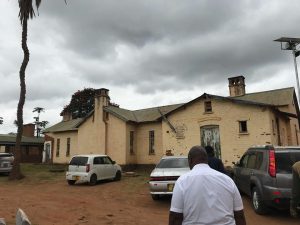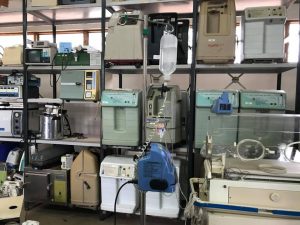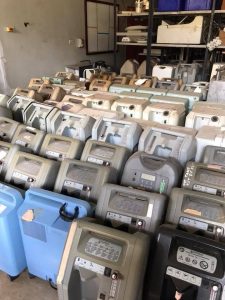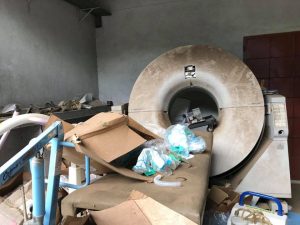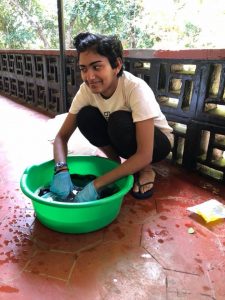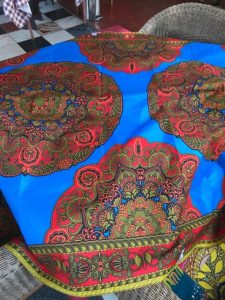Day 8
Sajel and I visited our third and final hospital in Zomba, which happened to be a central hospital rather than a district hospital. In fact, Zomba is the first central hospital built in Malawi. A lot of the older, more worn down parts of the hospital were built in the colonial times. Zomba was also the very first nursing school in Malawi, and Prince said he came to Zomba to train during his nursing school days.
In the nursery, we saw many of the same problems as in Thyolo and Mulanje.
- There are 30-40 infants, but only 3-4 nurses on duty. This is common in all the hospitals we’ve visited, so it makes it so difficult to test vitals and constantly check on the babies.
- We saw a continuous monitor in the corner of the ward that tracks temperature, oxygen levels, and pulse. However, it was broken and the spare parts were not readily available, so the nurses couldn’t use it.
- Sajel and I saw a baby being treated with gastroscesis there. I never saw an actual case of gastroscesis until that moment and it was truly eye opening. The nurse told us that since Zomba was a central hospital, they were able to treat gastroscesis. However, they didn’t have the special plastic gastroscesis bags (just like in the previous hospitals), so they used gauze also to cover the intestines prior to surgery.
We met Daniel at maternity and he told us that the most challenging aspect is checking for contractions. Ideally, the nurses try to check for contractions every hour by feeling with their hand and checking the amount of time between each contraction using a stopwatch. However, there are sometimes only 2 nurses for over 20 patients every day, and it takes at least 10 minutes to do this measurement. Daniel was really excited to talk to us because he is a huge advocate for maternal health. Every year he hosts a walk from Blantyre to Lilongwe (which is over FOUR HOURS AWAY by CAR). The walkers will stop at various locations and host events and talks educating people on maternal health! It’s such an amazing initiative and I’m excited to have gotten his contact information so I can learn more about what him and his team do!
Visiting PAM at every hospital was equally discouraging because it was like a graveyard for donated medical equipment. There were oxygen concentrators (which are so important for babies with birth asphyxia), syringe pumps, constant monitoring systems, and so many other devices that could be used in the wards but aren’t because they are broken. These devices may last for 6 months to a year, but then break down. Since these devices are donated from all over the world, it is difficult to order parts and components. And there are a ton of models for all the devices, so it is both expensive and inefficient to order components for all these different models.
Often times, these devices are donated with no user’s manual, so nurses and staff are not properly trained on how to use the devices. Furthermore, PAM workers are unsure of how to fix these devices. It’s so frustrating seeing this because sustainability is so important when it comes to medical devices. They can’t be donated without proper training to both the nurses and PAM workers and access to parts. Otherwise these devices will be unused and gaps will still exist in hospitals like Mulanje, Thyolo, and Zomba.
Day 9
We went to Queens today for a second time, and after visiting the district hospitals, I was able to see a lot of overlaps. Although Queens is one of the primary hospitals people are referred to, there are still some gaps. For example, the nursery had about six different syringe pumps, but none of them were being used because they were broken. And only two out of the six or so radiant heaters were working. For the most part, kangaroo care is heavily depended on (just like the other hospitals we visited).
And the PAM area was HUGE. There were rows and rows and ROWS of devices. It was bigger than any other site.
The PAM specialist told us that if the parts are available, they could fix devices in under an hour. But because parts are really hard to get, they are just holding the devices there. Some of the machines like the oxygen concentrators have been there for 2 years! We even saw an entire MRI machine 😮
Day 10
LAUNDRY DAY. Once again, I added too much laundry powder. Now, my pants are going to be crunchy like a chip.
Day 11
We drove out to Limbe today and visited the market there! It was HUGE. There were so many stalls lining the busy road, people yelling and bargaining for things. There were A LOT of shoe stores haha. I ended up buying really pretty cloth called a chitenja, and people use them for swaddles, dresses, and other things! I can’t sew but I’ll figure out something to do with it.
